So, you are thinking about moving to Cambodia?
Implementing and adapting to change is never easy. Seven years ago I was at a full circle stage in my life, and it was time to take on the unknown and make a life decision. Subsequently, it turned out to be the right move.
Together, with my beautiful partner Dary, we are now living out a simple existence on a mango farm in the southern province of Kep. Apart from managing the mango trees we are growing lots of vegetables and fruits, and also raising livestock.
Below is a bucket of information to help you hit the ground running if you are considering moving to Cambodia.
Put your boots on, and step inside the Kingdom of Wonder. Welcome to Cambodia!
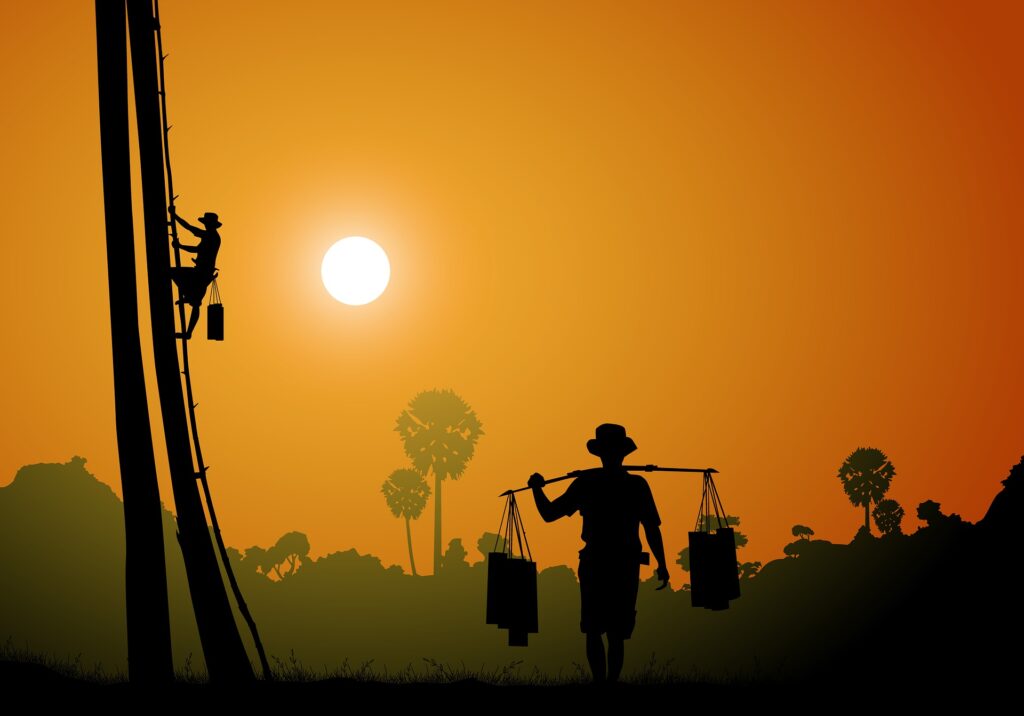
Visas and Work – Moving to Cambodia
Aside from loving the Asian culture, this was one of my main reasons for moving to Cambodia. Visas are easy to get! Get the correct visa and then you can find work. Or if you are 55 and over, you can apply for a “Retirement Visa”.

Visas
So, you have decided to take the plunge and move to Cambodia. These are the visas to look out for…
- Firstly, you must enter Cambodia on an Ordinary Visa, NOT a Tourist Visa. This visa (Ordinary Visa) is valid for one month and can then be extended for a period of 3, 6, or 12 months. If you do enter on a Tourist Visa, it can then be extended for another month whilst in-country. After that, you will have to cross the border and return.
- EB Visa (12 months/multi-entry visa) is the best visa if you are looking for work. Once you have found work, you will need to get a work permit. Your employer may help you; if not, you will need a letter from them and can then organize it yourself, or with the help of an agent.
- Retirement Visa (12 months/multi-entry visa) is the best visa if you just want to retire and do not want to work. Keep in mind, if you do obtain the “Retirement Visa”, by law 😉, you can’t gain employment.
Note: Yes, you can apply online or present yourself to the relevant ministries to obtain visas and work permits. Yet, to take all the hassle out of the process there are numerous agents that can do the job for you. Furthermore, if you do not have all the correct paperwork your visa or work permit will be declined. This is where the agents come in. They do charge extra, but, can get around all the red tape.
Work
There are a number of work opportunities available to ex-pats here in Cambodia. From teaching English to hospitality positions to specialized industries. Bring your skill-set along and start the job hunt. Just remember one thing, your wages will not be the same as home, but, relatively speaking you will get by.
Below are some online suggestions where you can start looking…
- Several Facebook groups deal specifically with job opportunities. “Phnom Penh Job Alerts”, “Phnom Penh Jobs for Foreigners”, and “Foreigner Job Postings”, just to name a few.
- Websites such as Bongtom.com, Camhr.com, Topjobcambodia.com, Jora.com, and many others list job opportunities for foreigners.
- If you are looking for a teaching position it can be best to physically turn up at the schools you have researched, and interview on the spot. The direct approach has worked for many English teachers. There are also some Facebook groups dedicated to teaching English. Click on the following link for TEACHING JOBS HERE.
- Cambodia is also great if you are a “digital nomad”. There are great spots in the country to work online and the internet is pretty reliable. Most cafes, bars, and restaurants offer free Wi-Fi also.
Phnom Penh – Moving to Cambodia – Where to Live
Phnom Penh will more than likely be your first port of call. I spent 6 years working in the nation’s capital before we purchased land and moved south onto the farm. Below are some suggested areas where to live in Phnom Penh.
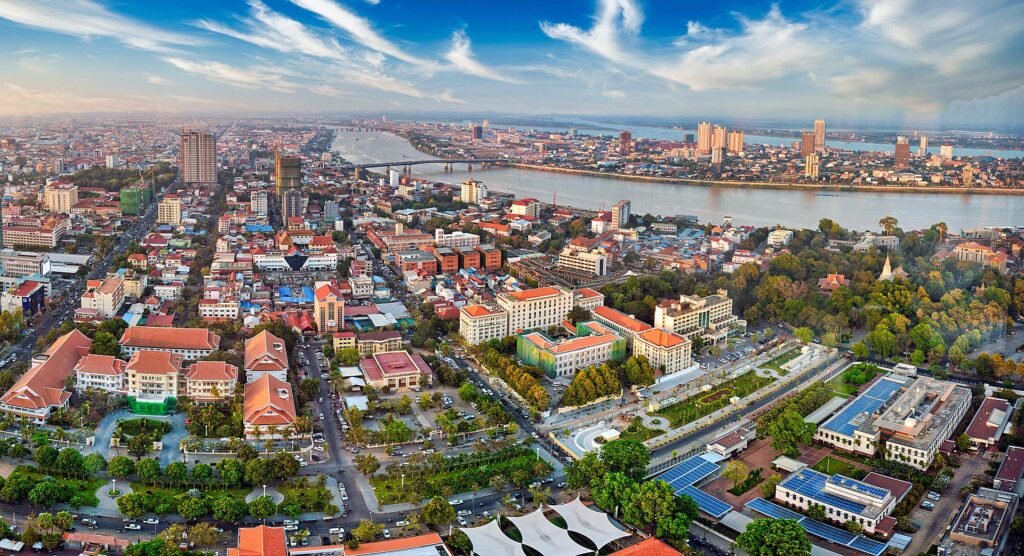
- Toul Tum Poung (Russian Market) – This area is located in the south of the city and is the go-to area for less expensive accommodation. A wide selection of apartment blocks to choose from ranging anywhere from $200 to $600/month. Plenty of western restaurants and supermarkets to choose from also.
- Beuong Tumpun – A little further out, but not too far from Toul Tum Pong. This area has a village feel and offers even cheaper accommodation. 3 story, 4 bedroom houses can be found for as cheap as $350. A great option if you are moving to Cambodia with a family. Not as many apartment blocks to choose from.
- Beung Keng Kang (BKK) – Closer to the city center, this area offers more up-market accommodation, hence, a little pricier. Many working professionals reside here as it is very centrally located with lots of restaurants, supermarkets, and bars to choose from. Apartment blocks range anywhere between $450 to $1200/month.
- Street 240 – An eccentric little enclave in the center of town. Home to a flamboyant mix of people, accommodation here is a little more boutique. Renovated French Colonial buildings grace the tree-lined streets and range anywhere from $750 to $1500/month. Not far from BKK.
- Wat Phnom Area – This area is classified as the CBD. Tall office blocks, 5-star hotels, embassies, and large, affluent addresses fill the Wat Phnom area. Expect to pay between $750 and $2000/month depending on your style of accommodation.
- Toul Kork – This area is located northwest of the CBD area and is a little further out. Many wealthy Cambodians reside here, noticeable by the huge homes and expensive cars that stick out like a sore thumb. Apartments go from $450/month and houses from $800/month. There are not as many western restaurants here, but the area does have some very good western supermarkets.
Note: The best way to search for your accommodation is either on the internet (Facebook Groups), in real estate offices, or just by driving around looking for signs out the front. When you do decide on a place that suits you, you will need to fill out a “lease agreement” and pay a one or two-month deposit upfront.
Phnom Penh Markets
Markets are abundant all across Phnom Penh. Wherever you live you are not far away! Below is a list of the major markets around town, bustling centers of activity, where you will be able to source most things.

- Psar Toul Tum Poung (Russian Market) – This market is located in the southern area of Phnom Penh and is mainly geared towards the tourists. Souvenirs and clothes are the main products traded, along with an assortment of kitchen shops and food stalls.
- Psar Themei (New Market) – Located not far from the riverside, in central Phnom Penh, its layout resembles walking inside a mandala. It spirals in all directions, and before you know it, you cannot find which way you came in! That being said, it’s a good market for buying clothes, gold, jewelry, and nic-nacs. Also, on the outer edge, there are some great food stalls offering seafood, BBQ chicken, and all the common Khmer dishes.
- Psar Orussey – This is my favorite market. If you are looking for equipment for your house or apartment, you will find it here at a very good price. They sell everything for the kitchen and garden, tools and electrical products. It is also a great place to pick up spices and rice in bulk.
- Psar Dam Kor – A large wholesale market, it’s located on Mao Tse Toung Boulevard. This is the dispatch market for Phnom Penh and the country’s provinces. Fresh produce is bulk delivered daily from the countryside, Vietnam and Thailand. If you own a restaurant, this is the place to come for your fresh fruit and vegetables.
Note: Bargaining is required in all markets, especially the Russian Market and Psar Themei. Firstly, cut the price in half and then negotiate from there. If you are still not happy just walk away! The vendors will usually call you back and give you their best possible price. You may still end up paying more than the locals, but not much more!
Getting Around
Whether it be getting around in the city or going in-country, there are many cheap and cheerful traveling options…
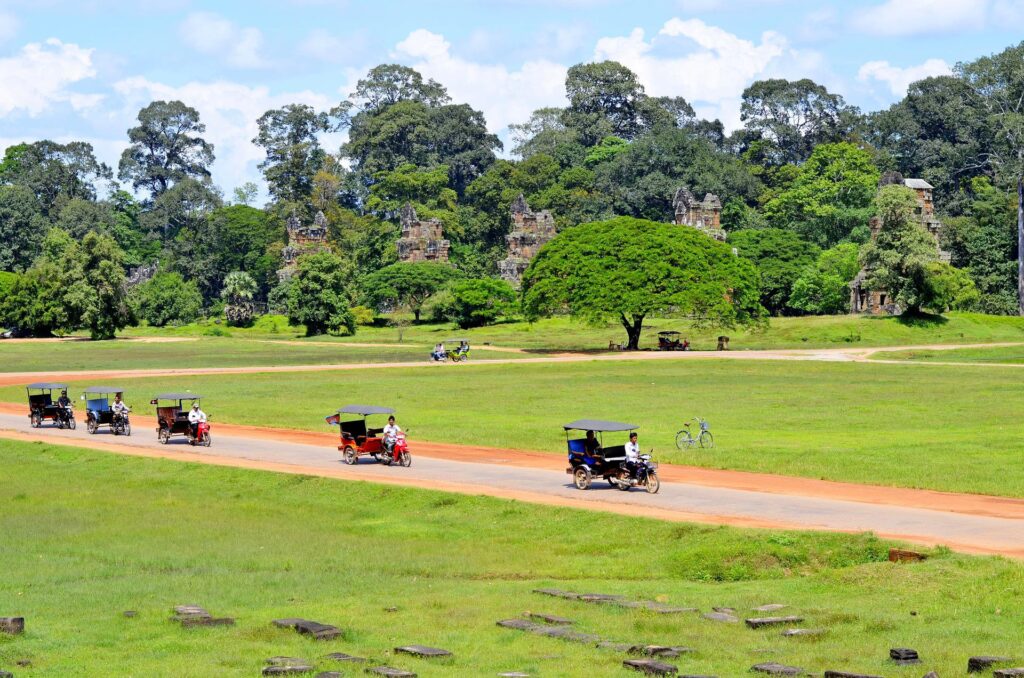
City
Passapp – These Indian-styled three-wheelers have taken over, and are the fastest and cheapest way to get around the city. Download the App on your phone and you are all set. No need to negotiate any prices, but leaving a small tip will always be greatly appreciated. Rides around the city will cost between $1.00 and $4.00 depending on where you are heading.
Tuk-Tuk – Aaaah, the romantic Tuk-Tuk. Yes, these are still available and are a good option for 3 or more people. They are more expensive than the Passapp and a price must be negotiated before you set off. These “chariots of Asia”, are slowly becoming a dying species, yet are still fun to get around in!
Motodop – On every corner, there is a man and his motorcycle waiting to take you somewhere. They call them the motodops, and can be quite handy if you are in a rush. They usually cost anywhere between $1 and $3, depending on where you are heading. Negotiate upfront and be sure to wear a helmet.
Country
Mini Buses – For me, they are the best way to get around. They usually seat around 15 people and are very affordable. They stop every 2 hours or so to use the toilets and get refreshments if needed. Click on the Bookmebus.com link to view your options. This is the website I use but there are others.
Buses – For longer distances, you might prefer a larger bus with overnight sleepers. They can be a good option for traveling to Siem Reap, Battambang, or even to Thailand and Vietnam. Very reasonably priced and very frequent. Giant Ibis and Virak Buntham are both recommended companies.
Private Taxis – A private taxi is suggested for those wanting their own space. They are all usually air-conditioned SUV’s and travel all over the country. Prices are negotiated upfront. They do cost extra, but you have the freedom to stop when you want to and will usually get to your destination faster than any bus.
Currency
Cambodia official currency is the riel, however, the US dollar is also widely used, especially in the city. There is talk of slowly phasing out the US dollar and reverting back to the riel. They have already started to phase out the $1.00 and $5.00 bills, yet it could be sometime, if at all, before we see a complete de-dollarization.

Some useful facts to know about the currency…
- The US dollar is approximately 4000 riel.
- Do not accept any torn or scruffy-looking US dollars as they will be rejected, however it is fine to use riel in any shape or form. Also note that old US currency will be rejected.
- Equally important, when traveling around the country it is best to take Cambodian Riel for ease of transaction. If you do have to pay with US dollars your change will more than likely be in riel.
- It is best to juggle the two currencies depending on the situation. For example, larger purchases are best made in US dollars, whilst shopping at your local market and paying tuk tuk drivers, use the riel.
- When withdrawing money from an ATM machine you can select which currency you wish to receive.
- If you do receive Cambodian riel as change from a US dollar purchase, make sure they give you the correct exchange rate.
The Weather – Moving to Cambodia
It doesn’t matter where you choose to live when you move to Cambodia. It’s hot everywhere. I have never sweated so much in my life, however, it’s great for the skin and a good way to lose those extra kilos.

There are 3 main seasons. The hot season, the wet season, and the warm season.
Hot Season – From March through to June the temperature consistently nudges 40 degrees Celsius. Your air-conditioner will be running 24/7 and you will definitely avoid heading outside between 10 am and 4 pm. If you have to, make sure you are well covered up and try to avoid direct sunlight.
Wet Season – The start of the rains usually begin around July and can last through to November. Whilst it is still very warm and also humid, it is celebrated by the farmers. Rice fields fill up. Mango plantations get a welcome watering, and the country dusts itself off, literally, from an oppressive, dry hot season. Everything turns green and it is a great time to travel to the countryside.
Warm Season – November to February is a welcome time. Some people call it the cool season, but It is still warm, without being too hot! It can also get a touch windy. This is Cambodia’s peak tourist season.
Food – Local Markets – Western Supermarkets
Home to the largest freshwater lake in the world, it goes without saying, that fish plays an integral part in the Cambodian diet. Fish, coupled with rice, form the staple food of the country, especially in the countryside.
Local markets are filled with fresh vegetables, fruit, fish, and meat and you will find western supermarkets in all major towns.
Local Markets
Wherever you live you are not far away from a local market. They are a great place to mix with the locals and pick up a wide selection of tropical fruits and vegetables. Fresh beef, pork, and chicken are also available plus an amazing selection of local, freshwater fish. It is best to get there early morning to firstly, avoid the heat, and secondly whilst everything is fresh.

Learning a little bit of market Cambodian will go a long way. You will be able to interact more and also make sure you are getting the right price. Prices are cheap, however, if the stall holders see a foreigner they can be tempted to nudge the price up. Overall, you will pick up your groceries for a lot less than you would back home.
Below is a random list of prices at the local market, just to give you an idea……
- Tomatoes – $1/kilo.
- Cucumbers $.75/kilo.
- Potatoes $1.25/kilo.
- Baguettes 25c each.
- Fresh pork is around $5/kilo.
- Sugar Cane Juice 50c each.
- Bananas 75c a bunch.
- Avocadoes $2.50/kilo.
- Mangoes $1 to $3 kilo depending on the season.
- Rice $0.75 to $2.50/kilo depending on the quality.
- Pork and rice (Cambodian breakfast) $1.25.
- Coca Cola 0.50c.
Western Supermarkets
Phnom Penh, Siem Reap, Battambang, Sihanoukville and Kampot all boast western supermarkets. Most of them are air-conditioned, and you will find most of your western products, but not all of them. Prices are more expensive, with the cost being not to dissimilar to back home.
On the shelves you will find imported meats and cheeses, milk and yogurt, breakfast cereals, tinned products, gourmet offerings and candy bars etc. etc. They are also good places to pick up spices, sauces, mustards and dressings.
The main supermarket names are BAYON, LUCKY, CHIPMONG, SUPER DUPER, FAIR PLUS, THAI HOUT, and AEON. There are also small convenience stores such as SMILE and KIWI MART. SEVEN-ELEVEN has also just opened its doors in Phnom Penh, so you can expect to see more of these open up in the country over the coming years.
Restaurants – Local – Moving to Cambodia
Local restaurants are everywhere serving a variety of dishes. Below is list of what to expect on the menu in the Cambodian eateries…
- Pork/Rice – Served in every restaurant )breakfast only) from the hours of 6 am to 9 am or sold out. Grilled pork served with rice, pickles, egg, and a small hot broth. Costs anywhere between 0.75c to $1.50.
- Kuy teav (Noodle soup) – Another breakfast dish served in restaurants and from street vendors. It consists of beef or pork broth flavored with garlic, herbs, and other aromatics, meatballs, and vermicelli noodles.

- Beef Lok Lak – Inspired by the French colonial days it has become one of Cambodia’s national dishes. Marinated and stir-fried pieces of beef and onions, served up with rice, lettuce, cucumbers, and tomatoes with a fried egg on top.
- Fish Amok – Dating back to the Khmer Empire this dish is distinctly Cambodian. It consists of a slightly sweet and spicy curry paste, steamed in a banana leaf with coconut cream and other aromatics. Garnished with kaffir lime leaf and chili and served with rice.
- Khmer Beef Salad – Raw beef marinated in lime juice, fish sauce and shallots. It is then mixed up with basil, mint, garlic, spicy chilies and topped with toasted rice.
Note Well: Most of the larger towns have FOOD DELIVERY APPS. The best one to download on to your phone is NHAM24. They have the best selection of restaurants and are the most reliable in terms of service. Eat in the luxury of your own home!
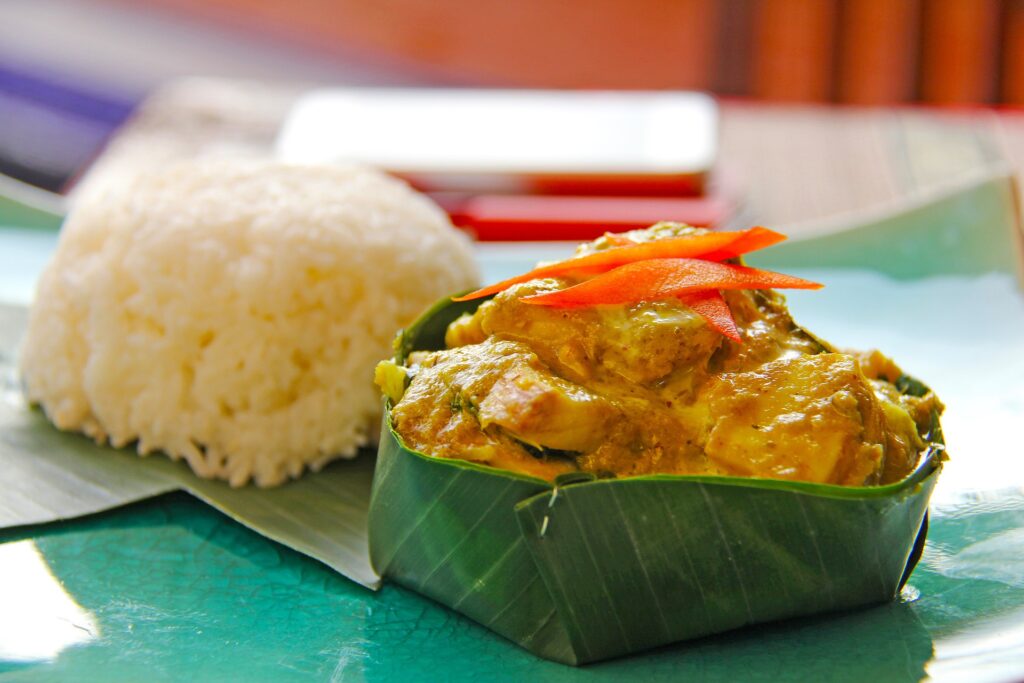
Restaurants – Western
It has taken a while for the western food scene to emerge in Phnom Penh and Cambodia, however, it is now steaming along! Phnom Penh and other provincial towns are now home to a myriad of dining options. You will find Japanese, Italian, Mexican, American, Chinese, Indian, and Korean restaurants scattered all-over Cambodia. Whilst many are still not getting it right, many others do! Below are a few recommendations of where to eat in Phnom Penh.
- Brooklyn Pizza and Bistro – Serving pizza and all your American favorites, this restaurant located in Toul Tum Pong is a crowd pleaser. open every day of the year!
- Mexicano – Located in BKK and serving up authentic Mexican food at reasonable prices.
- The Vine – A hair salon that serves arguably the best burgers in the city. Located near the riverside on street 244.
- Eric Kayser Bakery – Many locations around Phnom Penh serving a great selection of home baked bread and viennoiserie.
- Bistrot Langka – A modern bistro located in the BKK area. Offering a French and Cambodia fusion menu, using well-crafted techniques and great produce.
- Vibe Cafe – Located in Toul Tum Poung it is 100% vegetarian. Buddha and Acai bowls are listed on the menu, along with a great selection of very healthy smoothies.
Note: Here I have listed a few of my favorites, obviously there are many more to choose from. Tripadvisor can help you with your search.
Services – Moving to Cambodia
While the quality of services may not be as high as back home you can still get most things done here.
Banking – ABA, CANADIA and ACLEDA are the three main banks. It is very easy to open an account once you are established. Some of them also offer great interest rates if you are transferring a large sum of money. Everything is done online now, just download the apps once you have set up your bank account.
Dentistry – Cambodia is a great place to get your teeth done. Small or major works will cost a third of the price back home, and the quality is excellent. For example, I got 3 crowns put on and it cost me $2000 US. I can recommend ROOMCHANG Dental Hospital. They offer a very professional service, using the latest equipment, with many of their dentist’s training in Europe.
Hospitals – Cambodia is not renowned for its medical treatment, however, there are many hospitals and clinics that can help you out. If you do need major surgery or a specialized service it may be best to go to neighboring Thailand or get treatment back at home.
Internet and Phone – There are many phone and internet providers in Cambodia. Metphone, Smart Phone and Cell Card are the main providers. The internet is pretty consistent, yet if you are living a little remotely you can always purchase a router for a stronger connection. Sim cards can be purchased in one of the numerous phone shops, and can be topped up by purchasing a phone card.
Roadside Mechanics – If you have purchased a scooter to get around, fear not, there are roadside mechanics on every corner. If you have a flat tire or breakdown somewhere they are never far away and only charge a couple of dollars.
Coffee – There is a real coffee culture in Cambodia, and this is evident by the number of coffee shops and stands all over the country. From the local store, a cup of coffee will only cost you a dollar or so, while at the larger franchises you can expect to pay around $1.75 to $2.50. In my experience, the coffee is just as good from the local hawkers as opposed to a Starbucks or Brown coffee.
Bottled Water – It is wise to use bottled water for drinking, and brushing your teeth. You can buy large 1.5 liter bottles for 0.50c, or alternatively, they have 20 liter drums. The initial purchase of the 20 liter drum is $5, however, every time you need a refill it, it will only cost you $1.00. It makes sense to purchase the latter option.
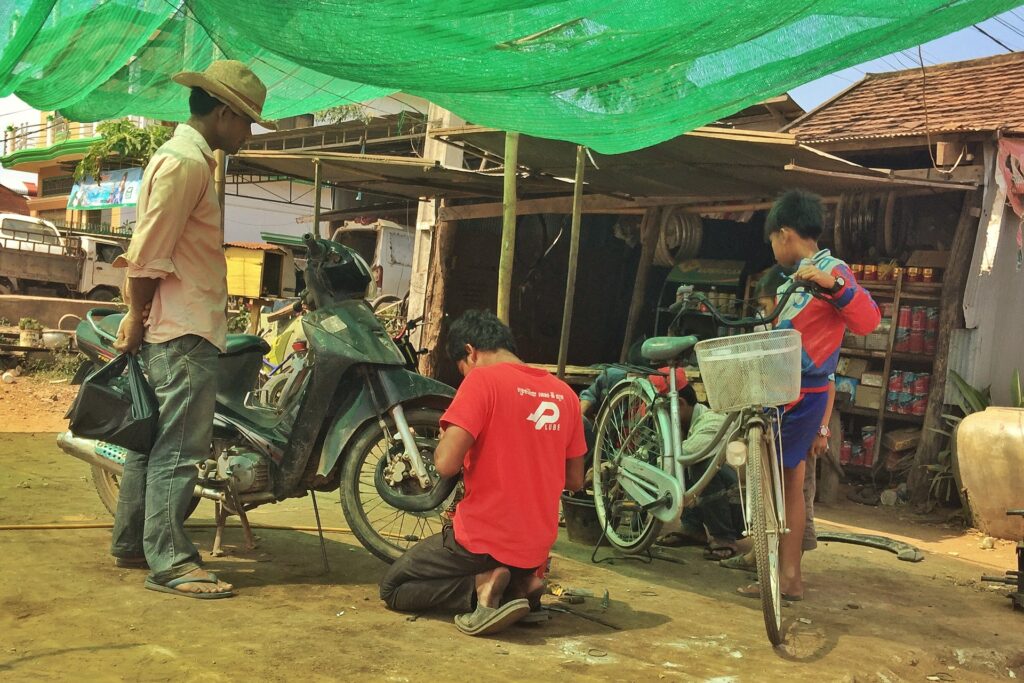
Learning the Language – Moving to Cambodia
I have been in Cambodia for 7 years now, and I still cannot converse fluently. I know lots of words and phrases, yet haven’t been able to master the language. Many foreigners do though, which makes me very jealous!
Nevertheless, it’s very important to be able to speak some of the language! To buy things in the marketplace, ask for directions, and get the bill in the restaurant, a basic understanding of the language is necessary. Also, understanding the more formal greeting and farewells, which show respect to the elders and important people, will be greatly appreciated.
A great place to start learning Cambodian is the YouTube Channel KHMER LESSON. His name is Dara, and he has been posting hundreds of short videos on YouTube since 2018. I can’t recommend him highly enough, a great source for picking up the language.
Pollution
Like many Asian and poorer countries, Cambodia has a pollution problem. The country’s infrastructure and lack of resources have left it high and dry when it comes to recycling and taking care of the environment. Plastic, amongst others, is the main problem. Everything from the local markets, to coffee stands and shops comes in plastic, which in turn, ends up on the side of the road, waterways or beaches.

They have no infrastructure to clean up this problem and are not educating the kids in the schools. It is very sad to see! When they do clean it up, it is piled up and burnt on the side of the road.
Many of the western restaurants in Phnom Penh are now using eco-friendly packaging, but there is a long way to go before we see a solution to this massive problem. The government and local authorities in the provinces need to step up and implement a strategy, however, I can’t see this happening anytime soon!
The Cambodian People
One of the delights of living in Cambodia is the people. Surviving such a bloodied history has given birth to a very resilient population, that lives simply and is just happy with the small things in life. They are a very friendly, and humorous people and will always greet you with a warm smile. “Have you eaten rice”, is the standard greeting when meeting people.
Cambodia is like one big farm with towns in between. The majority of the population is farmers. Agriculture plays a huge part in their life. Whether it be tending the cows, raising livestock, or maintaining the rice fields, the people have a real connection with the land, and subsequently, do not require much else to get by.
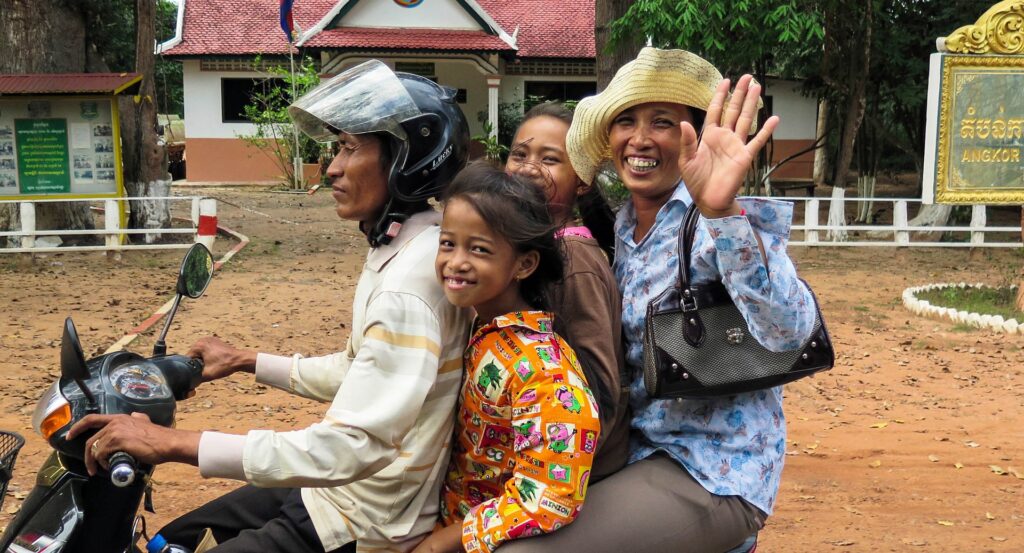
Public Holidays and Festivals
Cambodia has lots of public holidays. Times past there were 28 public holidays. Just this year, 2023, they have now reduced the amount to 23. This is great if you are a teacher or work in an office! The main holidays are Khmer New Year and Pchum Ben.
Khmer New Year – During this time businesses will close anywhere between 3 days and one week. People working in the cities will travel back to their home province and celebrate with family and friends. If you happen to be in Phnom Penh at this time, it will be the quietest you will ever see it. You can ride around on your bicycle with out a care in the world. Khmer New Year is usually in April sometime.
Pchum Ben or Ancestors Day – This is perhaps one of the more important festivals. The Cambodian people will travel back to their homeland and pay respects for their relatives who have passed before them. They will visit the pagodas or have the monks visit their house. It is here, they believe, that the for the deceased, the course of their journey will be decided by their actions, or Karma, of their past life. This festival actually last for 15 days, however, the government gives 3 days holiday for this festival.
Water Festival – The Water Festival, also known as Bon Om Touk marks the end of the rainy season as well as the change in the flow of the Tonle Sap River. Dragon boats races and fireworks are held to commemorate this joyous occasion which usually lasts for three days. Phnom Penh is a hive of activity during this time and can be a lot of fun!
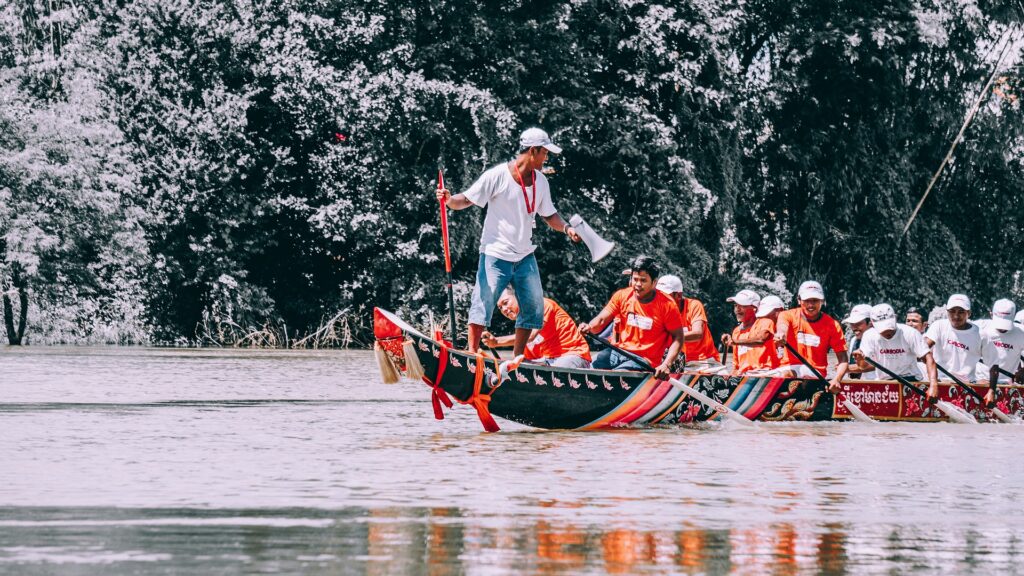
Buying Land and Apartments
Apartments – Foreigners can buy apartments in a building except for the ground floor.
Land – Foreigners cannot own land outright.
I have kept this simple, and will refer you to another website, that is more of an authority on this topic……
Here is an article from B2B Cambodia, Foreign property ownership in Cambodia.
Places to Live – Moving to Cambodia
There are 5 main areas where most ex-pats choose to live when moving to Cambodia.
Phnom Penh – Living in Cambodia
This is the nation’s capital and where the majority of the work is to be found. It is a hustle and bustle city with an underlying charm. As mentioned above, there are many areas to live in, depending on your budget and the location needed.
Here you will have access to western supermarkets, international schools, and all the required services whilst being surrounded by quality restaurants and intimate bars. Lots of local markets and a super variety of street food are always on offer.

Siem Reap
Siem Reap is 6 hours north of Phnom Penh by bus and it is home to the spectacular Angkor Wat. Many ex-pats choose to live here also, due to its laid-back vibe, and cost of living.
Very much a tourist town, due to its proximity to Angkor Wat. Lots of hotels, restaurants, and bars keep the tourists happy and ex-pats alike. Whilst being a beautiful place to live, there are not as many work opportunities for foreigners.

Battambang – Living in Cambodia
Battambang lies on either side of the meandering Sangkae River and is home to a small ex-pat community. It is also considered the arty center of Cambodia, with many artists hailing from the kingdom’s second-largest city.
It is a very picturesque, peaceful town with French Colonial buildings mixing with local shop-houses. Over the last few years, small cafes and accommodations have opened up, however, do not expect to be inundated with choices. Everything is very low-key here, adding to its charm.
Head out a few kilometers from town and you will be surrounded by agriculture. Battambang province is the largest producer of rice in Cambodia. The Cambodian orange is also grown in this area, and believe it or not, there is a small winery in town.

Sihanoukville
Lined with sandy beaches and swaying palm trees, Sihanoukville was once the spot to live. That was up until 3 or so years ago. Currently, development is at full speed, with Cambodian and Chinese investors trying to capitalize on this attractive stretch of coastline. High-rise apartment blocks and casinos are being erected at a startling rate, and the crime in the area has also increased.
Whilst the beaches and views out to the gulf of Thailand are still prominent, there is a different feeling in the air. Many ex-pats have now relocated to the Kampot area. In saying that, it is best to check it out for yourself and form your own opinion, as it is still a beautiful part of the country.
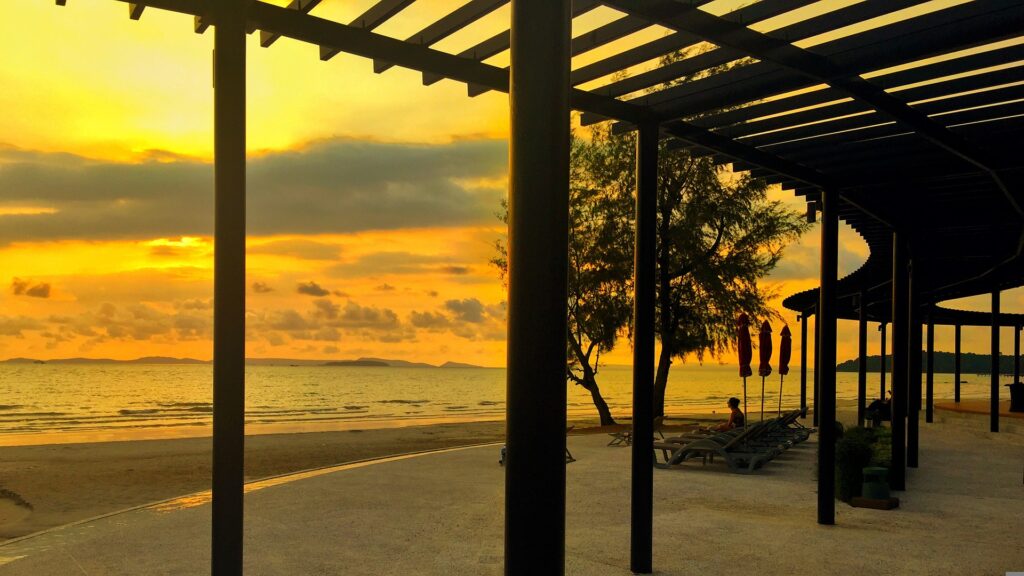
Kampot – Moving to Cambodia
The town of Kampot is a little gem that lies on either side of the Preaek Tuek Chhu River. Many, many ex-pats call Kampot home. It is a great place to retire, and furthermore, it is a great place to live out a simple existence on a small acreage if that’s what you are looking for.
The town itself has a beautiful array of French Colonial buildings, numerous cafes, restaurants, and bars and a great big local market to get lost in.
Surrounded by the foothills of the Elephant Mountains it is also blessed with some of the best pepper in the world and an abundance of mango plantations. Also, the famous Kampot Salt Fields are just a short drive away, where you can view the gentle art of salt farming.
Then, just 20 km down the road, is the seaside town of Kep, where the jungle meets the ocean. Check out my blog here.
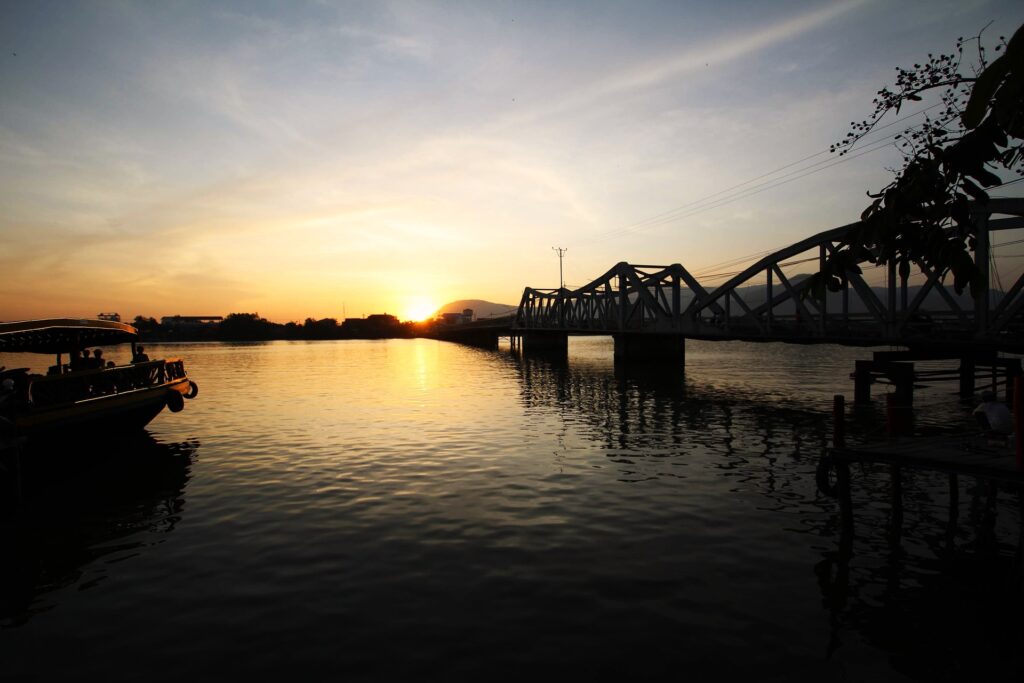
In Conclusion – Moving to Cambodia
So, you have made it this far in the blog. Well done, that’s a lot to take in!
If you have been thinking of moving to Cambodia, it is a good time to do so. With the passing of the pandemic, the country is now fully open, with lots of work opportunities available. Or if you just want to retire, there are many areas in the country that you would find enticing. You can also check out my blog here on the good and bad of Living in the Tropics!
I hope this information will be of value to you if you have been thinking of moving to Cambodia, and let me know in the comments if I can answer any other questions for you. Also, please share the BLOG if you know others that might be interested in moving to Cambodia.
Thanks for visiting Mangoes and Mandalas, and be sure to follow us on Instagram!


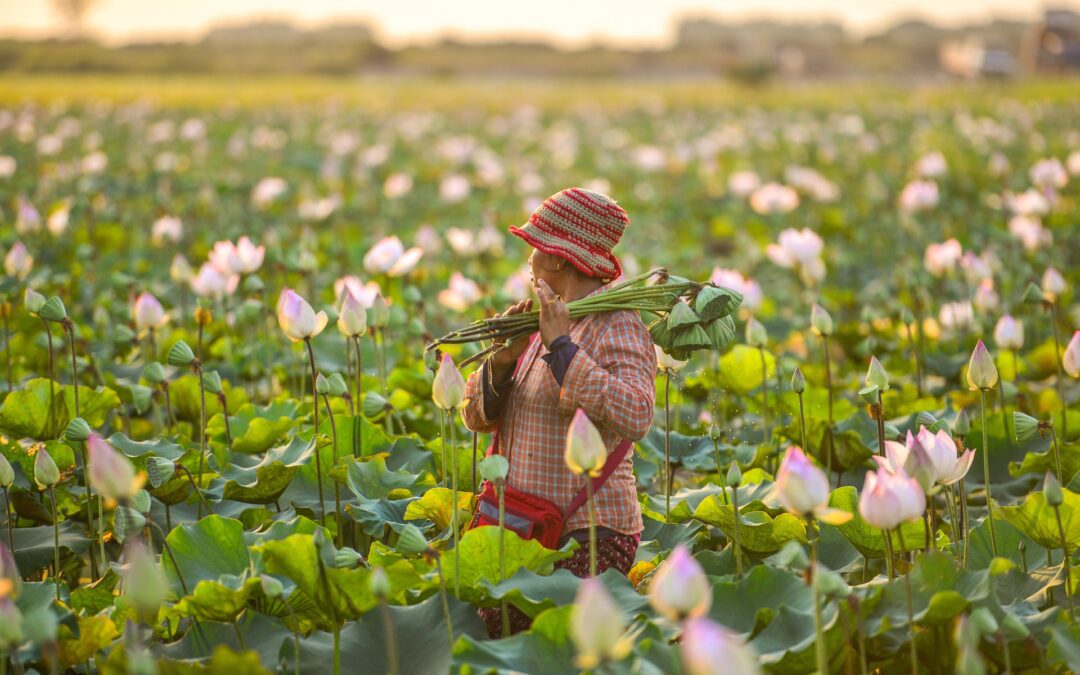
Very informative
Loved it.